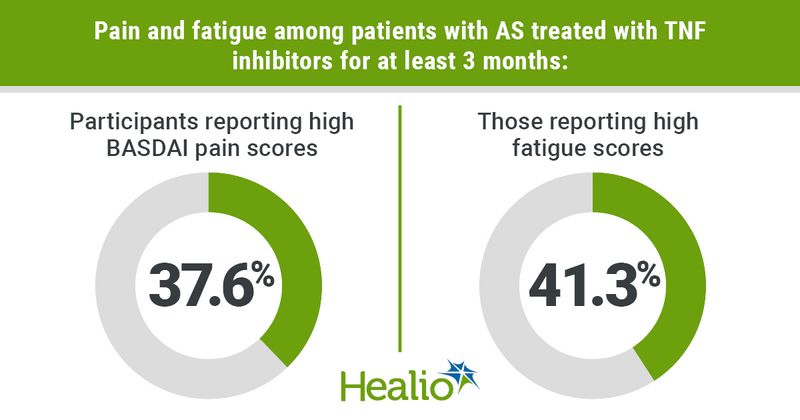Pain, fatigue persistent in ankylosing spondylitis despite TNF inhibitor use
Pain and fatigue levels remain high among patients with ankylosing spondylitis despite apparent disease control with biologic therapies, such as TNF inhibitors, according to a global survey published in the Journal of Clinical Rheumatology.
“Inflammatory back pain is a common complaint in AS patients and a component of the clinical criteria for the classification of AS, prevalent in up to 45% of AS patients,” Vibeke Strand, MD, of Stanford University, and colleagues wrote. “Fatigue, also common in AS patients, strongly correlates with pain and can be as difficult to manage, with a reported global prevalence of 45% based on a study of 6120 patients with rheumatic diseases from the Netherlands, Belgium, United Kingdom, United States, Canada, Germany, France, Spain, Argentina, Mexico, Chile, and Portugal.”

“Elevated levels of the proinflammatory cytokines tumor necrosis factor (TNF-), interleukin 6 (IL-6), IL-23, and IL-17 are present in the serum of patients with AS and implicated in mediation of inflammatory pain, fatigue, and depression,” they added. “Until recently, TNF inhibitors (TNFis) were the main biologic disease-modifying antirheumatic drugs for treatment of patients with persistently high disease activity despite regular use of nonsteroidal anti-inflammatory drugs (NSAIDs).”
To analyze the frequency and severity of persistent AS symptoms, as well as the impact of pain and fatigue on health-related quality of life (HRQoL), employment and work activity, Strand and colleagues examined data from the Adelphi Spondyloarthritis AS Disease Specific Program. According to the researchers, this survey was conducted in 13 countries across five continents between 2015 and 2016. Participants included patients with AS and their physicians in the United States, Mexico, France, Germany, Italy, Spain, the United Kingdom, Japan, South Korea, Taiwan, Australia, Turkey and the United Arab Emirates.

Physicians included in the survey completed a prespecified form for the next one-to-eight — depending on the country — consecutive patients with AS seen for diagnosis or routine care. Detailed questions covered patient demographics, clinical assessments, concomitant conditions — including fibromyalgia — medication use and treatment history. In addition, each patient for whom a form was completed by the physician was invited to complete a voluntary patient-reported form, providing informed consent to participate.
These patient-reported forms included the 3-level 5-dimension EuroQoL questionnaire, as well as the Bath Ankylosing Spondylitis Disease Activity Index (BASDAI), Medical Outcomes Study Short Form Health Survey version 2 (SF-36v2), and Work Productivity and Activity Impairment General Health Questionnaire (WPAI). In all, 705 patients, who had been receiving TNF inhibitors for 3 months or more, completed both BASDAI pain and fatigue survey domains.
According to the researchers, among those 705 participants, 37.6% reported high BASDAI pain scores, while 41.3% reported high fatigue scores. SF-36v2, 5-dimensional EuroQoL Questionnaire and 5-dimensional EuroQoL visual analog scale scores were significantly lower (P < .0001), and work productivity and activity impairment scores were significantly higher (P < .0001), among those with high levels of pain or fatigue compared with those with low levels.
“This real-world study agrees with previous reports that AS patients commonly report pain despite apparent control of disease with commonly available biologic therapies such as TNFis,” Strand and colleagues wrote. “These persistent high pain and/or fatigue levels place a high burden on patients in terms of [health-related] QoL, reducing their ability to contribute to society as part of the workforce. Improved treatment options (in addition to TNFis) in AS are urgently needed, and appropriate evaluation and management of pain and/or fatigue should be a focus of outcome measures in AS clinical trials.”
“Our observations indicate the importance of appropriately treating AS to minimize the impact on patients’ social lives, work participation, and economic and health burdens,” they added. “Lastly, our results highlight the need to explore other therapeutic approaches including nonpharmacologic interventions for the management of AS.”
